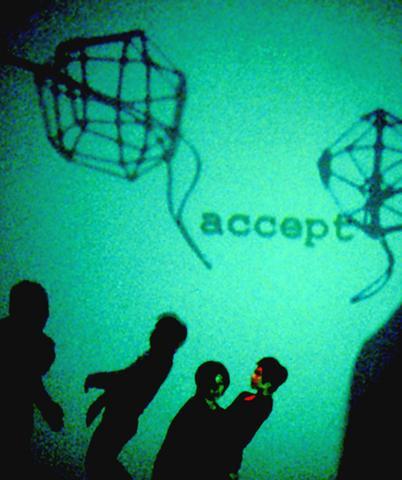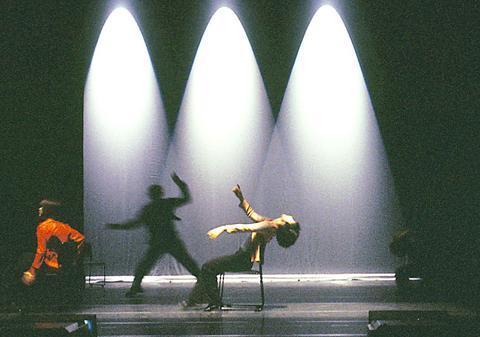The Novel Dance Series (
The series' artistic director Lin Huei-min

PHOTO COURTESY OF NOVEL HALLN
Tokyo-based Leni-Basso is a rising star in European contemporary dance circles, while Akiko Kitamura, the group's choreographer, infuses modern technology with martial arts-influenced dance. With the aid of dramatic lighting, sounds and video projection, her pieces often shock the audience with their visual impact and fierceness.

"Leni Basso!" meaning "Leni is back" in the language of the Nuba tribe, was what the native Africans shouted joyfully to each other in the 1960s when the late German photographer and filmmaker Leni Riefenstahl filmed there. It is not generally known, but Riefenstahl had a short yet brilliant career as a dancer. When Kitamura set up her group in 1994, she named it Leni Basso to remind herself of the adventurous genius.
Leni-Basso's 2001 work Finks has its dancers moving quite unexpectedly in an exploration of the physical communication between dancers. In some scenes, the dancers seemingly engage in an intense street fight. Their dances overlaps with real-time video projections of the dance in the background. Deafening noise from two large speakers also strengthens the sense of unrestrained disorder and violence.
"The work is about the possibility of physical communication between people. This communication may be not always be smooth. We just look to express how our bodies feel about other people's bodies," Kitamura said. "All the sounds and lighting are involved in a `discussion.'"
"Dancers not only communicate with each other, but communicate with the video projections and the sound effects. These multimedia elements also
communicate with each other."
Performing in Taipei, the group's 10th anniversary has special meaning for Ryuichi Fuse, its administrative director. "In 1999, we performed a short piece in Taipei. It was our first show abroad. Coming back to Taipei means a lot to us," Fuse said.
After its premiere in Tokyo in 2001, Finks toured Denmark, Belgium, North America and China, before coming to Taiwan.
Dumb Type, which hails from Kyoto, will perform next weekend. Made up of a group of former college students discontent with the educational establishment, the group set out to be different both in life and in dance.
Voyage is their latest work and conjures up a virtual journey on a stage in which social phenomena are examined and sometimes subtly criticized.

June 2 to June 8 Taiwan’s woodcutters believe that if they see even one speck of red in their cooked rice, no matter how small, an accident is going to happen. Peng Chin-tian (彭錦田) swears that this has proven to be true at every stop during his decades-long career in the logging industry. Along with mining, timber harvesting was once considered the most dangerous profession in Taiwan. Not only were mishaps common during all stages of processing, it was difficult to transport the injured to get medical treatment. Many died during the arduous journey. Peng recounts some of his accidents in

“Why does Taiwan identity decline?”a group of researchers lead by University of Nevada political scientist Austin Wang (王宏恩) asked in a recent paper. After all, it is not difficult to explain the rise in Taiwanese identity after the early 1990s. But no model predicted its decline during the 2016-2018 period, they say. After testing various alternative explanations, Wang et al argue that the fall-off in Taiwanese identity during that period is related to voter hedging based on the performance of the Democratic Progressive Party (DPP). Since the DPP is perceived as the guardian of Taiwan identity, when it performs well,

A short walk beneath the dense Amazon canopy, the forest abruptly opens up. Fallen logs are rotting, the trees grow sparser and the temperature rises in places sunlight hits the ground. This is what 24 years of severe drought looks like in the world’s largest rainforest. But this patch of degraded forest, about the size of a soccer field, is a scientific experiment. Launched in 2000 by Brazilian and British scientists, Esecaflor — short for “Forest Drought Study Project” in Portuguese — set out to simulate a future in which the changing climate could deplete the Amazon of rainfall. It is

What does the Taiwan People’s Party (TPP) in the Huang Kuo-chang (黃國昌) era stand for? What sets it apart from their allies, the Chinese Nationalist Party (KMT)? With some shifts in tone and emphasis, the KMT’s stances have not changed significantly since the late 2000s and the era of former president Ma Ying-jeou (馬英九). The Democratic Progressive Party’s (DPP) current platform formed in the mid-2010s under the guidance of Tsai Ing-wen (蔡英文), and current President William Lai (賴清德) campaigned on continuity. Though their ideological stances may be a bit stale, they have the advantage of being broadly understood by the voters.